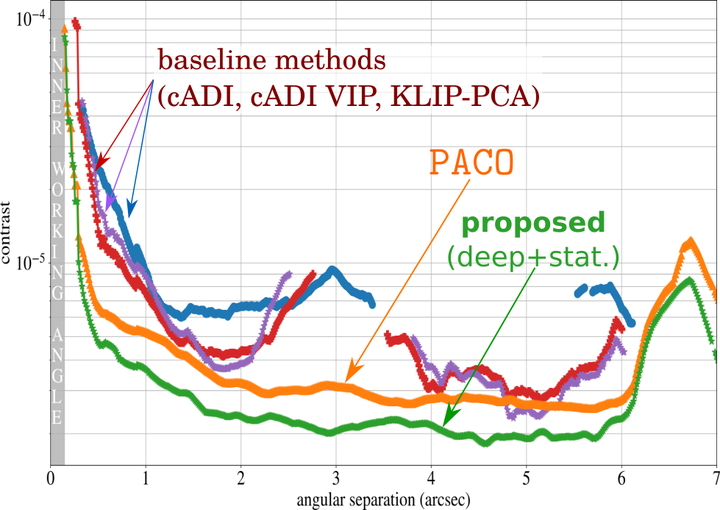New post-processing algorithms for exoplanet detection and circumstellar disk reconstruction by direct imaging
In the spirit of Lyot
 Quantitative comparison (with contrast curves –the lower the better–) of the performances of the proposed algorithm for exoplanet detection combinining statistical modeling and deep learning. Results obtained on data from the VLT/SPHERE instrument.
Quantitative comparison (with contrast curves –the lower the better–) of the performances of the proposed algorithm for exoplanet detection combinining statistical modeling and deep learning. Results obtained on data from the VLT/SPHERE instrument.
Abstract
Studying the circumstellar environmment by direct imaging is an active research topic in astronomy. The very high contrast between the host star and the objects of interest (exoplanets and disk) makes the task particularly challenging thus requiring sophisticated post-processing algorithms. We will present the key concepts of two new algorithms dedicated on (i) exoplanet detection, and (ii) cirumstellar disk reconstruction. Regarding exoplanet detection, we propose to combine the statistics-based model of the PACO algorithm (Flasseur et al., 2018, A&A, A138) with a deep-based model in a three steps algorithm. We apply our method on more than ten datasets from the VLT/SPHERE-IRDIS instrument and compare it with PACO and other baseline methods. Our results show that the proposed method outperforms the comparative algorithms, with a typical improvement up to half a magnitude with respect to PACO. Regarding circumstellar disk reconstruction, we recently proposed the REXPACO (Flasseur et al., 2021, A&A A62) algorithm. Our method amounts to jointly estimating the object of interest and the statistics of the nuisance component using the PACO framework. We show how the original algorithm can be modified to deal with Angular and Spectral Differential Imaging (ASDI) data and restore deblurred multispectral images of the circumstellar environment.